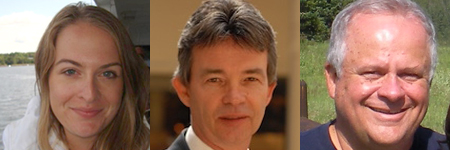 I recently posted this query on LinkedIn based on this blog post in BoardSource about helping staff to fully engage board members in successful fundraising: http://exceptionalboards.com/2013/10/09/helping-our-staff-help-our-board-to-fundraise/. What ensued was an interesting exchange of perspectives. It certainly felt great to engage others in real discussion.
I recently posted this query on LinkedIn based on this blog post in BoardSource about helping staff to fully engage board members in successful fundraising: http://exceptionalboards.com/2013/10/09/helping-our-staff-help-our-board-to-fundraise/. What ensued was an interesting exchange of perspectives. It certainly felt great to engage others in real discussion.
Dale Otto
Non-profit consulting and leadership development
The first challenge is an obvious one, many board members believe that it is the role of the staff to do fundraising. To engage your board, staff must provide a clearly defined process, who do you need the board to contact and for what purpose, specific points that need to be made to the donor, what type of support can the board member expect from staff, what are the time expectations from the board member?
I also believe board members can’t fundraise for programs they don’t understand or a mission they may not be clear about. Your board orientation is the starting point for establishing these criteria.
Pon Angara
Principal and Creative Director at Barkada Circle
The board orientation is a crucial first step to getting everyone on the same page about mission, culture and expectations. Thanks for your comment, Dale!
Melissa Kaestner
Nonprofit executive with expertise in organizational development and fundraising
Board orientation is indeed very important. I also like one-pagers that members can keep on hand that summarize information from the orientation: basic info, mission, list of programs/services/etc. with one or two sentence descriptions, maybe a stat/metric or two. Ongoing and open communications is also key.
I also think it is important for board members to realize that there is more to fundraising than soliciting donations. They can:
- be a member of the fundraising committee (help strategize, assess donor prospects, review past activities, support the ED/DD, etc.)
- do their part in ensuring the board undertakes/participates/reviews strategic development planning, has a healthy, accountable, and transparent structure, and works with the committee/ED/DD as needed
- read reports/plans from the ED/DD before meetings
- talk about the organization when talking to their contacts or networking (they don’t have to ask for money, it can be PR)
- provide names to the committee/ED/DD from their own contacts/network that could be potential donors
- attend events/activities of the organization
- participate in donor follow-up by saying thank-you with telephone calls or letters
- make a personal contribution within their means that is meaningful to them
In any case, I think it is important that board members receive training specific to your culture/needs/activities/approach, especially if they are going to participate in the asking directly. It is important for there to be consistency. It also can be a huge stepping stone on the path of members being able to take ownership of their work. As not every organization has experienced EDs or the means to employ someone specifically focused on fundraising/development, this may seem like a challenge. You can hire short-term consultants, but you can also recruit fundraising experts to your board who would be willing to provide that training (which could be part/all of their personal contribution). And don’t forget, those board members will need resources too, such as brochures or reports.
James Garland
COO/CFO Norwalk YMCA
Setting expectation is critical, so I certainly agree with the Board orientation comments. Melissa has a great list of points as engagement is the key from which the donative impulse flows. An additional point would be to have your nominating committee be composed of the most engaged Board members.
From my experience, after the Executive and Finance committee, the Nominating committee, which should include the Board Chair and CEO, is the most important as it serves to recruit the types of individuals who will govern (and contribute to) your organization for the next decade. Generally, according to the laws of human nature, “like attracts like.” If your stronger members are organizing the recruiting, they are more likely to attract strong members. If this task is treated as an afterthought and includes Board members that are just given a role to have a role, you may get also-ran recruits.
Pon: Excellent point, James! I’m on the Board of a nonprofit and we’re in the process of recruiting new members. Our President has been leading up the charge and we already have three great candidates express interest.
Eugene Fram
Professor Emeritus at Saunders College of Business, Rochester Institute of Technology
In the 21st century, NFP boards need a process for allowing individual directors to have occasional informal contact with key staff members, with PROPER feedback to the chief executive, allowing for confidentiality if the staff person desires it. I have successfully followed this process as a director on both FP and NFP boards.
Pon: Thanks, Eugene. In what context have you found this type of contact to be most successful?
Eugene: Pon: I see the CEO needing to be a voting member of the board. As such he has responsibilities for operations and also is the representative of the staff on the board, developing a real board-CEO-staff partnership. This is not theory, it works in practice. I can provide some personal citations on implementation for you if you wish. .
Dwain Cox
Independent Consultant
All of you have made excellent points — I would like to make two points :
- The ED and Boards need to identify what “skill sets” are needed on the Board, then identify who on your Board meet/have those skills; if needed skills cannot be filled by current members then start identifying potential Board members that can meet the skills — then go recruit those folks.
- Fundraising follows from you having a documented “fund development plan” that has measurable/actionable items in the plan. Constant evaluation of where you are on meeting the goals is required. You cannot wait until the established date of the goal to find out that you failed. No excuses.
Pon: Great points, thanks Dwain! More and more, I’m hearing that we need to look beyond conventional fundraising and foster a true culture of philanthropy rooted in building relationships. What does this look like to you?
Dwain: Pon thanks. Building relationships with potential donors is critical and doing that well requires pairing up the right board member with the donor. Who will have the “chemistry” to get the intended result? I definitely would have the CEO/ ED as a voting member. Many bylaws exclude that. I have been a nonvoting ED on a board. I found that if you “work” the influential members you can get your vote in.
Pon: Would you say that having the CEO/ED as a voting member on the Board is more common in for-profit corporations?
Dwain: Pon, my for-profit experience has been in very large corporations. The CEO/ chairman have been voting members. In the nonprofit organizations it is even more vital that the ED have a vote — why? The ED is more aware of the business issues than any board member.
Eugene: Dwain: I totally agree. SEE: http://nd.alliance1.org/content/what%E2%80%99s-name-benefits-presidentceo-title. Pon: Yes more common in FPs. Some NFP state statutes list it as a conflict of interest for the CEO to be a voting member of the board, or even being a nonvoting board member. Quite antiquated thinking in my opinion. See link above.
Pon: It seems to me this conversation can easily/naturally flow into the subject of trust building between board members and staff.
Eugene: Yes; Trust has to be a critical element.
Many thanks to Dale Otto, Melissa Kaestner, James Garland, Eugene Fram and Dwain Cox for contributing to the conversation.







